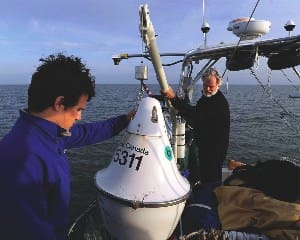At a time when oceanographic research is usually conducted by large, diesel-drivens ships, the idea of doing ocean research using a 64-foot sailboat like Ocean Watch, currently circumnavigating the Americas, may seem odd. But gathering scientific data under sail harkens back to the beginnings of ocean research &mdash sailing vessels such as Capt. Cook’s Endeavour, HMS Beagle, HMS Challenger and R/V Atlantis, the 142-foot ketch that was the first research vessel for the Woods Hole Oceanographic Institution.
Ocean Watch, a steel sloop built in Maryland in 1988 and captained by solo race veteran Mark Schrader, is undertaking a 25,000-mile passage around North and South America under the auspices of the environmental group Sailors for the Sea and the Pacific Science Center in Seattle. The idea behind the voyage is to promote the need for healthy oceans. A large part of the expedition is funded by the Tiffany & Co. Foundation.
In addition to the environmental aspects of the voyage, Ocean Watch is also being used to gather useful scientific data. To this end, 10 scientists from seven institutions (University of Washington’s Applied Physics Laboratory, the Joint Institute for the Study of the Atmosphere and Ocean, RMR Co., MIT Sea Grant, NASA, Western Washington University, and Yale University) are participating in the Around the Americas science program. These scientists have placed a variety of instruments aboard Ocean Watch. For the most part, the sloop is not set up to continuously collect data, but the crew and scientist on board will collect “datasets of opportunity.” The research topics include studying sea ice, weather, jellyfish populations and underwater sound. Altogether, eight different scientific projects will be undertaken during Ocean Watch‘s planned 13-month passage around the two American continents.
Drift buoys are a common way to study ocean currents. A drift buoy is designed to broadcast its position via satellite to allow oceanographers to track how these buoys are affected by surface currents. Ocean Watch has deployed buoys as part of a study called the International Arctic Buoy Program (IABP). These buoys weigh in at 45 pounds and have sensors for measuring air pressure and surface temperature. Since 1979, the IABP has deployed more than 900 of these buoys. The buoys typically transmit data for two years before falling silent. In addition to deploying buoys, Ocean Watch has also helped recover a buoy that was deployed in 2006 and had run aground near Barrow, Alaska. Using coordinates provided by scientists, Ocean Watch was able to find the buoy and take it aboard. The retreived buoy will be sent to Christian Michelsen Research in Norway for refurbishing and redeployment.
Dr. Michael Reynolds, a specialist in scientific instrumentation with degrees in Electrical Engineering, Oceanography, and a Ph.D. in Atmospheric Sciences, was aboard Ocean Watch for the boat’s leg across the Gulf of Alaska to Point Barrow to study ocean acidification. The level of acid in seawater has risen slightly in many places in the world. Scientists speculate that one reason for this is carbon from atmospheric carbon dioxide reacting with ocean water to form carbonic acid. As the ocean becomes more acidic, it puts stress on some populations of sea life. Reynolds, who has performed oceanography on large research vessels noted the difference working on Ocean Watch. “The amount of science is limited due to the limited space,” Reynolds said. “Instead of running tens of different studies, we can do only a few.”
One of the experiments Reynolds installed on Ocean Watch involves sampling ocean water for temperature, salinity, dissolved oxygen, and pH. This is done via an underway sampling system provided by The International SeaKeepers Society. Seawater is pumped aboard via a thru-hull fitting, sent to a tank where an instrument made by Idronaut, an Italian scientific instuments company, can measure the desired parameters. The water is pumped overboard via another thru-hull.
Other experiments involve a permanently-mounted hydrophone, a jellyfish survey, using a small remotely operated vehicle (ROV) for gathering seawater samples when in port, meteorological studies and more.
The hydrophone is used for recording the underwater sounds of marine mammals, along with the more general background sound found in different ports. These sound observations will be matched with photos and video recordings of marine animals taken at the same time to discern if sound pollution is influencing marine animal populations.
Ocean scientists remain largely in the dark as to the extent of jellyfish populations and there is limited data measuring populations over wide geographic areas. The jellyfish study will use video cameras mounted on the stern of Ocean Watch to count jellyfish.
When Ocean Watch is in port, crewmembers will use a small ROV called a Sea Perch, to collect water samples. The Sea Perch unit is part of an MIT Sea Grant College Program to gather water quality data worldwide.
The meteorological studies won’t be absorbing the time of the Ocean Watch crew. The vessel has a meteorological unit that automatically gathers data on winds, air temperature, humidity, pressure, solar radiation, infrared radiation, and sea temperature.
While the scientific efforts of Ocean Watch hardly indicate a return to sail-powered research vessels, it is intriguing to see the contribution that a voyage like this can make to scientific understanding of the oceans.

